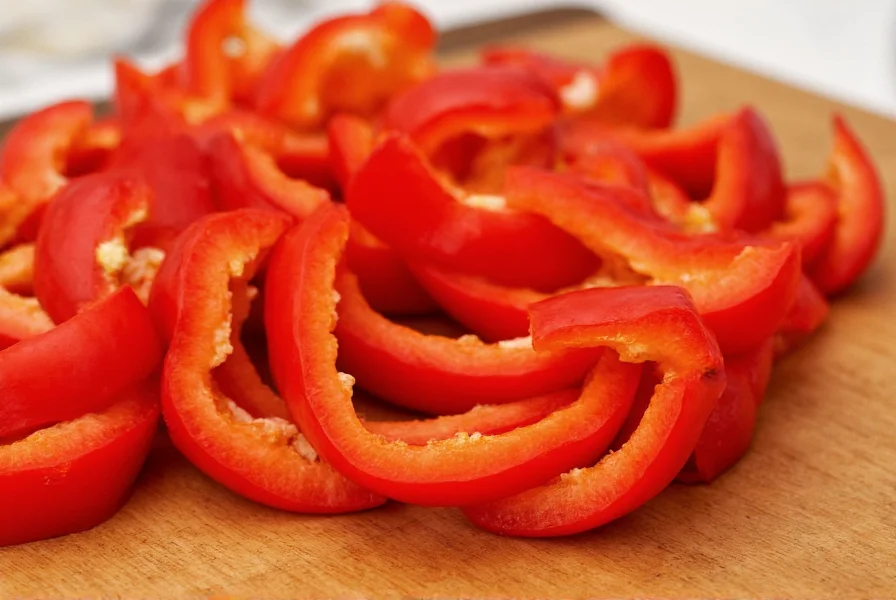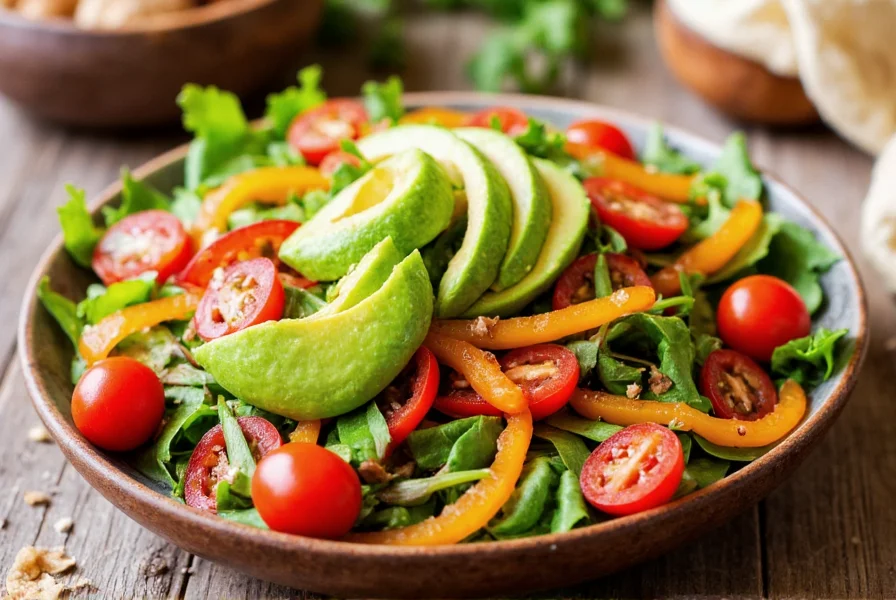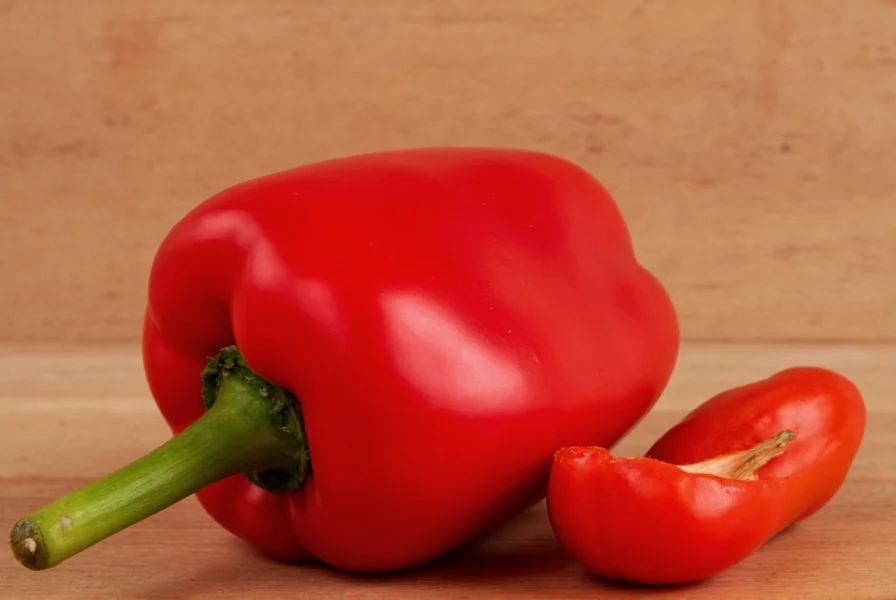Red bell peppers are among the most nutrient-dense vegetables you can add to your diet. Beyond their modest calorie count, they offer impressive nutritional benefits that make them stand out from other colorful varieties. Understanding the complete nutritional profile helps explain why nutritionists consistently recommend incorporating red bell peppers into balanced meal plans.
Nutritional Breakdown of Red Bell Peppers
While the calorie content is certainly noteworthy, the real value of red bell peppers lies in their exceptional nutrient density. A medium red bell pepper provides significantly more nutritional value per calorie than many other common vegetables.
| Nutrient | Amount per Medium Pepper (119g) | % Daily Value |
|---|---|---|
| Calories | 37 | 2% |
| Total Carbohydrates | 9g | 3% |
| Dietary Fiber | 3g | 11% |
| Vitamin C | 152mg | 169% |
| Vitamin A | 3131IU | 63% |
| Vitamin B6 | 0.3mg | 15% |
| Vitamin K | 8mcg | 7% |
| Potassium | 314mg | 9% |
The vitamin C content in red bell peppers is particularly impressive—nearly 170% of your daily requirement in just one medium pepper. This antioxidant powerhouse supports immune function, skin health, and iron absorption from plant-based foods.
Red Bell Pepper vs. Other Colored Varieties
Many people wonder how red bell peppers compare to their green and yellow counterparts in terms of calories and nutrition. While the calorie differences are minimal, the nutritional profiles vary significantly due to ripeness.
Green bell peppers are harvested earlier than red ones, which affects their nutritional composition. A medium green bell pepper contains about 30 calories—slightly fewer than red peppers—but has less vitamin C and virtually no beta-carotene. As bell peppers ripen from green to red, their sugar content increases slightly (explaining the higher calorie count), but they develop substantially more antioxidants and vitamins.
Yellow bell peppers fall somewhere in between, with approximately 34 calories per medium pepper and vitamin levels that exceed green peppers but don't quite reach red pepper levels. The extended ripening process that creates red bell peppers allows for greater development of beneficial compounds like lycopene and beta-carotene.

Health Benefits Beyond Calories
The low-calorie nature of red bell peppers makes them ideal for weight management, but their health benefits extend far beyond simple calorie counting. The combination of high fiber content and substantial water composition (about 92% water) creates a food that promotes satiety without excess calories.
Research shows that the antioxidants in red bell peppers, particularly vitamin C and carotenoids, help reduce inflammation and may lower the risk of chronic diseases. The capsaicinoids present in smaller amounts than in hot peppers still contribute to metabolic benefits. For those concerned about blood sugar management, red bell peppers have a low glycemic index and won't cause significant blood sugar spikes.
Serving Size Considerations
Understanding how serving sizes affect calorie calculations is essential for accurate dietary tracking. While a medium red bell pepper (about 119g) contains 37 calories, it's helpful to know how this translates to common measurements:
- 1 cup chopped red bell pepper: approximately 29 calories
- 100g raw red bell pepper: about 31 calories
- 1 ounce (28g) raw red bell pepper: roughly 9 calories
Cooking methods can slightly alter the calorie density. Roasting or grilling doesn't significantly change the calorie content, though some water loss may concentrate nutrients slightly. Avoid adding oils or sauces if you're tracking calories strictly, as these additions can substantially increase the calorie count.
Practical Ways to Enjoy Red Bell Peppers
Incorporating red bell peppers into your diet is both simple and delicious. Their sweet flavor makes them versatile across various meal types. Try adding sliced red bell peppers to salads for a nutrient boost, or roast them to bring out their natural sweetness for pasta dishes and sandwiches.
For snackers, red bell pepper strips pair wonderfully with hummus or Greek yogurt-based dips. They work equally well in cooked applications—stir-fries, omelets, and grain bowls all benefit from their color and nutrition. When meal prepping, store cut red bell peppers in airtight containers for quick access throughout the week.

Selecting and Storing for Maximum Nutrition
To get the most nutritional value from your red bell peppers, proper selection and storage matter. Choose peppers that feel heavy for their size with taut, glossy skin. Deep red color indicates full ripeness and maximum nutrient development.
Store whole peppers in the crisper drawer of your refrigerator for up to two weeks. Once cut, store in an airtight container for 3-4 days. While some nutrient loss occurs over time, proper storage minimizes this. Avoid washing peppers until ready to use, as excess moisture can accelerate spoilage.
Frequently Asked Questions
How many calories are in a cup of red bell pepper?
One cup of chopped red bell pepper contains approximately 29 calories. This serving size provides about 135% of the daily recommended intake of vitamin C and 2 grams of dietary fiber, making it an extremely nutrient-dense food choice.
Are red bell peppers good for weight loss?
Yes, red bell peppers are excellent for weight loss due to their low calorie density and high nutrient content. With only 37 calories per medium pepper and 3 grams of fiber, they help you feel full while providing substantial nutritional value. Their high water content (92%) also contributes to satiety without adding calories.
Do cooked red bell peppers have the same calories as raw?
The calorie content remains virtually identical whether red bell peppers are raw or cooked. A medium cooked red bell pepper still contains approximately 37 calories. However, cooking can slightly concentrate nutrients as water evaporates, and adding oils or sauces during cooking will increase the total calorie count.
Why do red bell peppers have more calories than green ones?
Red bell peppers contain slightly more calories than green ones (37 vs 30 per medium pepper) because they've been allowed to fully ripen on the vine. This extended ripening process increases their natural sugar content, which slightly raises the calorie count while dramatically improving their nutritional profile, particularly for vitamins A and C and antioxidant compounds.
How do red bell peppers compare to other vegetables for vitamin C?
Red bell peppers contain more vitamin C than oranges by weight. One medium red bell pepper provides 152mg of vitamin C (169% of daily value), compared to approximately 70mg in a medium orange. They significantly outperform most common vegetables in vitamin C content, containing nearly three times more than broccoli and over five times more than spinach by weight.











 浙公网安备
33010002000092号
浙公网安备
33010002000092号 浙B2-20120091-4
浙B2-20120091-4